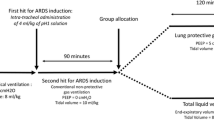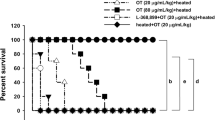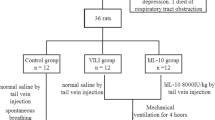Abstract
Alveolar hemorrhage and pulmonary edema induced by mechanical ventilation are partly dependent on cardiac output. Because cardiac output is low during hypothermia, we hypothesized that hypothermia may protect against these vascular manifestations of ventilator-induced lung injury. Twenty-seven Sprague-Dawley rats were assigned to either normothermia (37 ± 1°C)-injurious ventilation (NT; n = 10), hypothermia (27 ± 1°C)- injurious ventilation (HT; n = 10), or nonventilated control (n = 7). The two ventilated groups were subjected to injurious ventilation of peak airway pressure 30 cm H2O with zero end-expiratory pressure for 20 min. Compared with the NT group, the hemorrhage/congestion score of the lung (11.2 ± 1.5 vs. 4.7 ± 1.6; p < 0.001) and the ratio of wet/dry lung weight (6.1 ± 0.8 vs. 5.0 ± 0.1; p = 0.046) of the HT group were lower. Compared with the NT group, protein concentration (3,471 ± 1,985 µg/ml vs. 1,374 ± 726 µg/ml; p = 0.003) and lactate dehydrogenase level (0.43 ± 0.22 U/ml vs. 0.18 ± 0.1 U/ml; p = 0.046) in bronchoalveolar lavage fluid of the HT group were lower. Whereas pressure-volume curve was shifted to the right in the NT group after injurious ventilation, it was not shifted in the HT group. In conclusion, hypothermia in rats attenuated the degrees of vascular manifestations and alveolar epithelial injuries induced by injurious ventilation, and preserved the mechanical properties of the lung.





Similar content being viewed by others
References
MB Amato CS Barbas DM Medeiros et al. (1998) ArticleTitleEffect of a protective-ventilation strategy on mortality in the acute respiratory distress syndrome. N Engl J Med 338 347–354 Occurrence Handle1:STN:280:DyaK1c7ht1ejtw%3D%3D Occurrence Handle9449727
R Behnia A Molteni CM Waters RJ Panos WF Ward HW Schnaper CH TS'Ao (1996) ArticleTitleEarly markers of ventilator-induced lung injury in rats. Ann Clin Lab Sci 26 437–450 Occurrence Handle1:STN:280:ByiD3szntVA%3D Occurrence Handle8879362
S Bernard (1996) ArticleTitleInduced hypothermia in intensive care medicine. Anaesth Intens Care 24 382–388 Occurrence Handle1:STN:280:BymA1MbjvVI%3D
WD Biggar D Bohn G Kent (1983) ArticleTitleNeutrophil circulation and release from bone marrow during hypothermia. Infect Immun 40 708–712 Occurrence Handle1:STN:280:BiyC1cvntlU%3D Occurrence Handle6840858
AF Broccard JR Hotchkiss N Kuwayama et al. (1998) ArticleTitleConsequences of vascular flow on lung injury induced by mechanical ventilation. Am J Respir Crit Care Med 157 1935–1942 Occurrence Handle1:STN:280:DyaK1c3osFygug%3D%3D Occurrence Handle9620930
A Broccard RS Shapiro LL Schmitz AB Adams A Nahum JJ Marini (2000) ArticleTitleProne positioning attenuates and redistributes ventilator-induced lung injury in dogs. Crit Care Med 28 295–303 Occurrence Handle1:STN:280:DC%2BD3c7ntVChuw%3D%3D Occurrence Handle10708156
Z Bshouty J Ali M Younes (1988) ArticleTitleEffect of tidal volume and PEEP on rate of edema formation in in situ perfused canine lobes. J Appl Physiol 64 1900–1907 Occurrence Handle1:STN:280:BieB2s3ovVE%3D Occurrence Handle3292503
M Colmenero-Ruiz E Fernandez-Mondejar MA Fernandez-Sacristan R Rivera-Fernandez G Vazquez-Mata (1997) ArticleTitlePEEP and low tidal volume ventilation reduce lung water in porcine pulmonary edema. Am J Respir Crit Care Med 155 964–970 Occurrence Handle1:STN:280:ByiB2MflsF0%3D Occurrence Handle9117033
TC Corbridge LD Wood GP Crawford MJ Chudoba J Yanos JI Sznajder (1990) ArticleTitleAdverse effects of large tidal volume and low PEEP in canine acid aspiration. Am Rev Respir Dis 142 311–315 Occurrence Handle1:STN:280:By%2BA2czhtlM%3D Occurrence Handle2200314
RH Demling NC Staub LH Edmunds Jr (1975) ArticleTitleEffect of end-expiratory airway pressure on accumulation of extravascular lung water. J Appl Physiol 38 907–912 Occurrence Handle1:STN:280:CSqC2M7jvVY%3D Occurrence Handle1126901
D Dreyfuss G Basset P Soler G Saumon (1985) ArticleTitleIntermittent positive-pressure hyperventilation with high inflation pressures produces pulmonary microvascular injury in rats. Am Rev Respir Dis 132 880–888 Occurrence Handle1:STN:280:BimD38zotlY%3D Occurrence Handle3901844
D Dreyfuss G Saumon (1993) ArticleTitleRole of tidal volume, FRC, and end-inspiratory volume in the development of pulmonary edema following mechanical ventilation. Am Rev Respir Dis 148 1194–1203 Occurrence Handle1:STN:280:ByuD2MjmvV0%3D Occurrence Handle8239153
D Dreyfuss G Saumon (1998) ArticleTitleVentilator-induced lung injury. Am J Respir Crit Care Med 157 294–323 Occurrence Handle1:STN:280:DyaK1c7gs1SqsA%3D%3D Occurrence Handle9445314
D Dreyfuss P Soler G Basset G Saumon (1988) ArticleTitleHigh inflation pressure pulmonary edema. Respective effects of high airway pressure, high tidal volume, and positive end-expiratory pressure. Am Rev Respir Dis 137 1159–1164 Occurrence Handle1:STN:280:BiaD28%2Fms1w%3D Occurrence Handle3057957
G Eshel G Reisler M Berkovitch S Shapira E Grauer J Barr (2002) ArticleTitleComparison of fast versus slow rewarming following acute moderate hypothermia in rats. Paediatr Anesth 12 235–242 Occurrence Handle10.1046/j.1460-9592.2002.00801.x
Z Fu ML Costello K Tsukimoto et al. (1992) ArticleTitleHigh lung volume increases stress failure in pulmonary capillaries. J Appl Physiol 73 123–133 Occurrence Handle1:STN:280:By2A2s3lsFE%3D Occurrence Handle1506359
L Gattinoni M Bombino P Pelosi et al. (1994) ArticleTitleLung structure and function in different stages of severe adult respiratory distress syndrome. JAMA 271 1772–1779 Occurrence Handle1:STN:280:ByuB2MvhslY%3D Occurrence Handle8196122
GF Hartree (1972) ArticleTitleDetermination of protein: a modification of the Lowry method that gives a linear photometric response. Anal Biochem 48 422–427 Occurrence Handle1:CAS:528:DyaE38XksVGjur0%3D Occurrence Handle4115981
I Hasinoff J Ducas RM Prewitt (1988) ArticleTitleIncreased cardiac output increases lung water in canine permeability pulmonary edema. J Crit Care 3 225–231
JR Hotchkiss Jr L Blanch G Murias et al. (2000) ArticleTitleEffects of decreased respiratory frequency on ventilator-induced lung injury. Am J Respir Crit Care Med 161 463–468 Occurrence Handle1:STN:280:DC%2BD3c7otVamtw%3D%3D Occurrence Handle10673186
JG Laffey D Engelberts BP Kavanagh (2000) ArticleTitleInjurious effects of hypocapnic alkalosis in the isolated lung. Am J Respir Crit Care Med 162 399–405 Occurrence Handle1:STN:280:DC%2BD3cvjtlCjsA%3D%3D Occurrence Handle10934060
J Mead T Takishima D Leith (1970) ArticleTitleStress distribution in lungs: a model of pulmonary elasticity. J Appl Physiol 28 596–608 Occurrence Handle1:STN:280:CS%2BC2sjntlM%3D Occurrence Handle5442255
Y Moshkovitz TE David M Caleb CM Feindel MP de Sa (1998) ArticleTitleCirculatory arrest under moderate systemic hypothermia and cold retrograde cerebral perfusion. Ann Thorac Surg 66 1179–1184 Occurrence Handle10.1016/S0003-4975(98)00805-4 Occurrence Handle1:STN:280:DyaK1M%2FhsFChsA%3D%3D Occurrence Handle9800803
S Nyren M Mure H Jacobsson SA Larsson SG Lindahl (1999) ArticleTitlePulmonary perfusion is more uniform in the prone than in the supine position: scintigraphy in healthy humans. J Appl Physiol 86 1135–1141 Occurrence Handle1:STN:280:DyaK1M3htVaqug%3D%3D Occurrence Handle10194194
JC Parker MI Townsley B Rippe AE Taylor J Thigpen (1984) ArticleTitleIncreased microvascular permeability in dog lungs due to high peak airway pressures. J Appl Physiol 57 1809–1816 Occurrence Handle1:STN:280:BiqD2sblt10%3D Occurrence Handle6511554
L Puybasset P Cluzel N Chao AS Slutsky P Coriat JJ Rouby (1998) ArticleTitleA computed tomography scan assessment of regional lung volume in acute lung injury. The CT Scan ARDS Study Group. Am J Respir Crit Care Med 158 1644–1655 Occurrence Handle1:STN:280:DyaK1M%2FjsVOmtw%3D%3D Occurrence Handle9817720
T Sakuma T Nishimura K Usude M Handa G Okaniwa S Suzuki S Fujimura (1997) ArticleTitleHypothermia inhibits the alveolar epithelial injury caused by hyposmotic albumin solution during preservation of the resected human lung. Surg Today 27 527–533 Occurrence Handle1:STN:280:ByiH2M7mtVU%3D Occurrence Handle9306546
K Shibata N Cregg D Engelberts A Takeuchi L Fedorko BP Kavanagh (1998) ArticleTitleHypercapnic acidosis may attenuate acute lung injury by inhibition of endogenous xanthine oxidase. Am J Respir Crit Care Med 158 1578–1584 Occurrence Handle1:STN:280:DyaK1M%2FjsVOntA%3D%3D Occurrence Handle9817711
SE Sinclair DA Kregenow WJ Lamm IR Starr EY Chi MP Hlastala (2002) ArticleTitleHypercapnic acidosis is protective in an in vivo model of ventilator-induced lung injury. Am J Respir Crit Care Med 166 403–408 Occurrence Handle10.1164/rccm.200112-117OC Occurrence Handle12153979
InstitutionalAuthorNameThe Acute Respiratory Distress Syndrome Network (2000) ArticleTitleVentilation with lower tidal volumes as compared with traditional tidal volumes for acute lung injury and the acute respiratory distress syndrome. N Engl J Med 342 1301–1308 Occurrence Handle10793162
T Toung P Saharia S Permutt GD Zuidema JL Cameron (1977) ArticleTitleAspiration pneumonia: beneficial and harmful effects of positive end-expiratory pressure. Surgery 82 279–283 Occurrence Handle1:STN:280:CSiB3MnkvVI%3D Occurrence Handle327600
DJ Tschumperlin J Oswari AS Margulies (2000) ArticleTitleDeformation-induced injury of alveolar epithelial cells. Effect of frequency, duration, and amplitude. Am J Respir Crit Care Med 162 357–362 Occurrence Handle1:STN:280:DC%2BD3cvjtleqtw%3D%3D Occurrence Handle10934053
K Tsuno K Miura M Takeya T Kolobow T Morioka (1991) ArticleTitleHistopathologic pulmonary changes from mechanical ventilation at high peak airway pressures. Am Rev Respir Dis 143 1115–1120 Occurrence Handle1:STN:280:By6B387jslI%3D Occurrence Handle2024823
T Tveita K Ytrehus M Skandfer et al. (1996) ArticleTitleChanges in blood flow distribution and capillary function after deep hypothermia in rat. Can J Physiol Pharm 74 376–381 Occurrence Handle10.1139/cjpp-74-4-376 Occurrence Handle1:CAS:528:DyaK28XksV2jurk%3D
SM Walther KB Domino RW Glenny MP Hlastala (1999) ArticleTitlePositive end-expiratory pressure redistributes perfusion to dependent lung regions in supine but not in prone lambs. Crit Care Med 27 37–45 Occurrence Handle1:STN:280:DyaK1M7jtFGqsg%3D%3D Occurrence Handle9934891
HH Webb DF Tierney (1974) ArticleTitleExperimental pulmonary edema due to intermittent positive pressure ventilation with high inflation pressures. Protection by positive end-expiratory pressure. Am Rev Respir Dis 110 556–565 Occurrence Handle1:STN:280:CSqD2M3psFA%3D Occurrence Handle4611290
C Wenisch E Narzt DI Sessler et al. (1996) ArticleTitleMild intraoperative hypothermia reduces production of reactive oxygen intermediates by polymorphonuclear leukocytes. Anesth Analg 82 810–816 Occurrence Handle1:STN:280:BymB3c7otlc%3D Occurrence Handle8615502
Acknowledgements
This study was supported by a fund from the Asan Institute for Life Sciences (#2001-161) and a fund from the Korean Academy of Tuberculosis and Respiratory Diseases (2000).
Author information
Authors and Affiliations
Corresponding author
Rights and permissions
About this article
Cite this article
Lim, CM., Hong, SB., Koh, Y. et al. Hypothermia Attenuates Vascular Manifestations of Ventilator-Induced Lung Injury in Rats . Lung 181, 23–34 (2003). https://doi.org/10.1007/s00408-002-0111-x
Accepted:
Issue Date:
DOI: https://doi.org/10.1007/s00408-002-0111-x




